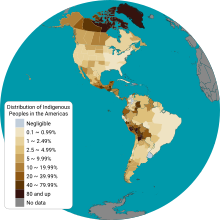Indigenous people of North America

Current distribution of the indigenous peoples of the Americas
|
|
| Total population | |
|---|---|
| Approximately 60.5 million | |
| Regions with significant populations | |
|
|
25.7 million |
|
|
6.8 million |
|
|
6.0 million |
|
|
5.8 million |
|
|
3.4 million |
|
|
3–5 million |
|
|
2.0 million |
|
|
1.4 million |
|
|
1.4 million |
|
|
955,000 |
|
|
818,000 |
|
|
524,000 |
|
|
520,000 |
|
|
444,000 |
|
|
204,000 |
|
|
95,000 |
|
|
70,000 |
|
|
114,000 |
|
|
60,000 |
|
|
51,000 |
|
|
24,500 (Maya) |
|
|
19,000 |
|
|
12,000–24,000 |
|
|
1,500 |
| Languages | |
| Indigenous languages of the Americas, English, Spanish, Portuguese, French, Danish, Dutch | |
| Religion | |
The indigenous peoples of the Americas are the pre-Columbian peoples of the Americas and their descendants.
Indígenas or pueblos indígenas ("indigenous peoples") is a common term in Spanish-speaking countries, and pueblos nativos or nativos (lit. "native peoples" in the sense of descendants of non-immigrants) may also be heard, while aborigen (aborigine) is used in Argentina, and pueblos aborígenes (aboriginal peoples) is common in Chile. The term "Amerindian" (short for "'Indians' of the Americas)" is used in Quebec, the Guianas, and the English-speaking Caribbean. Indigenous peoples are commonly known in Canada as Aboriginal peoples, which includes not only First Nations and Arctic Inuit, but also the minority population of First Nations-European mixed-race Métis people who identify culturally and ethnically with indigenous peoplehood. This is contrasted, for instance, to the American Indian-European mixed-race mestizos of Hispanic America (caboclos in Brazil) who, with their larger population (in most Latin American countries constituting either outright majorities, pluralities, or at the least large minorities), identify largely as a new ethnic group distinct from both Europeans and Indigenous Americans, but still considering themselves a subset of the European-derived Hispanic peoplehood in culture and ethnicity.
Indigenous peoples of the United States are commonly known as Native Americans or American Indians, and Alaska Natives.
...
Wikipedia
